Northeast India
Northeast India | |
|---|---|
| North Eastern Region (NER) | |
 | |
 | |
| Coordinates: 26°N 91°E / 26°N 91°ECoordinates: 26°N 91°E / 26°N 91°E | |
| Country | |
| States |
|
| Largest city | Guwahati |
| Major cities (2011 Census of India)[1] |
|
| Area | |
| • Total | 262,179 km2 (101,228 sq mi) |
| Population (2011 Census of India) | |
| • Total | 45,772,188 |
| • Density | 173/km2 (450/sq mi) |
| Time zone | UTC+5:30 (Indian Standard Time) |
| Official languages |
|
Northeast India (officially North Eastern Region, NER) is the easternmost region of India representing both a geographic and political administrative division of the country. It comprises eight states – Arunachal Pradesh, Assam, Manipur, Meghalaya, Mizoram, Nagaland, Tripura and Sikkim.[2]
The region shares an international border of 5,182 kilometres (3,220 mi) (about 99 percent of its total geographical boundary) with several neighbouring countries – 1,395 kilometres (867 mi) with Tibet Autonomous Region, China in the north, 1,640 kilometres (1,020 mi) with Myanmar in the east, 1,596 kilometres (992 mi) with Bangladesh in the south-west, 97 kilometres (60 mi) with Nepal in the west, and 455 kilometres (283 mi) with Bhutan in the north-west.[3] It comprises an area of 262,230 square kilometres (101,250 sq mi), almost 8 percent of that of India.
The states of North Eastern Region are officially recognised under the North Eastern Council (NEC),[2] constituted in 1971 as the acting agency for the development of the north eastern states. Long after induction of NEC, Sikkim formed part of the North Eastern Region as the eighth state in 2002.[4][5] India's Look-East connectivity projects connect Northeast India to East Asia and ASEAN. Guwahati city in Assam is called the Gateway to the North East and is the largest metropolis in North East India.
History[]
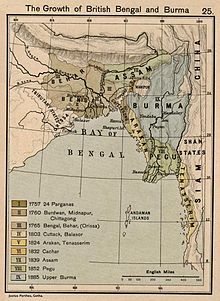
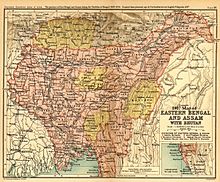
The earliest settlers may have been Austroasiatic languages speakers from Southeast Asia, followed by Tibeto-Burmese from China and by 500 BCE Indo-Aryans speakers from Gangetic Plains and from southern Yunnan Prefecture and Shan State.[6] Due to the bio- and crop diversity of the region, archaeological researchers believe that early settlers of Northeast India had domesticated several important plants.[7] Writers believe that the 100 BCE writings of Chinese explorer Zhang Qian indicate an early trade route via Northeast India.[8] The Periplus of the Erythraean Sea mention a people called Sêsatai in the region,[9] who produced malabathron, so prized in the old world.[10] Ptolemy's Geographia (2nd century CE) calls the region Kirrhadia after the Kirata population.[11]
In the early historical period (most of first millennium CE), Kamarupa straddled most of present-day Northeast India, besides Bhutan and Sylhet in Bangladesh. Xuanzang, a travelling Chinese Buddhist monk, visited Kamarupa in the 7th century CE. He described the people as "short in stature and black-looking", whose speech differed a little from mid-India and who were of simple but violent disposition. He wrote that the people in Kamarupa knew of Sichuan, which lay to the kingdom's east beyond a treacherous mountain.[12]
According to Ming Shi Lu, Different kingdoms of this region were well known to chinese in 15th-16th century : Da Gu-la , Xia Gu-la and Ba-jia-ta (Ahom or Pre-Ahom polities) , Di-Ban (Mong Tipam), Tei-ji-li (Kachari or Koch), Di-ma-sa (Hill Cachar) and Di-wu-la (Tripura).[13]
The northeastern states were established during the British Raj of the 19th and early 20th centuries, when they became relatively isolated from traditional trading partners such as Bhutan and Myanmar.[14] Many of the peoples in present-day Mizoram, Meghalaya and Nagaland converted to Christianity under the influence of British (Welsh) missionaries.
Formation of North Eastern states[]
In the early 19th century, both the Ahom and the Manipur kingdoms fell to a Burmese invasion. The ensuing First Anglo-Burmese War resulted in the entire region coming under British control. In the colonial period (1826–1947), North East India was made a part of Bengal Province from 1839 to 1873, after which Colonial Assam became its own province,[15] but which included Sylhet.
After Indian Independence from British Rule in 1947, the Northeastern region of British India consisted of Assam and the princely states of Manipur and Tripura. Subsequently, Nagaland in 1963, Meghalaya in 1972, Arunachal Pradesh in 1975 (capital changed to Itanagar) (formed on 20 February 1987) and Mizoram in 1987 were formed out of the large territory of Assam.[16] Manipur and Tripura remained Union Territories of India from 1956 until 1972, when they attained fully-fledged statehood. Sikkim was integrated as the eighth North Eastern Council state in 2002.[4]
The city of Shillong served as the capital of the Assam province created during British Rule. It remained the capital of undivided Assam until the formation of the state of Meghalaya in 1972.[17] The capital of Assam was shifted to Dispur, a part of Guwahati, and Shillong was designated as the capital of Meghalaya.
| State | Historic Name | Capital(s) | Statehood |
|---|---|---|---|
| Arunachal Pradesh | North-East Frontier Agency | Itanagar | 1987 (earlier a Union Territory of India, constituted in 1971)[18] |
| Assam | Kamarupa | Shillong (till 1969), Dispur | 1947 |
| Manipur | Kangleipak[19] | Imphal | 1971 (earlier a Union Territory of India, constituted in 1956)[18] |
| Meghalaya | Khasi hills, Jaintia hills and Garo hills | Shillong | 1971[18] |
| Mizoram | Lushai hills | Aizawl | 1987 (earlier a Union Territory of India, constituted in 1971)[18][20] |
| Nagaland | Naga Hills District | Kohima | 1963 |
| Sikkim | Sukhim | Gangtok | 1975 |
| Tripura | Tipperah[21] | Agartala | 1971 (earlier a Union Territory of India, constituted in 1956)[18] |
World War II[]
In 1944, the Japanese planned a daring attack on British India. Traveling through Burma, its forces were stopped at Kohima and Imphal by British and Indian troops. This marked the furthest western expansion of the Japanese Empire; its defeat in this area presaged Allied victory.
Sino-Indian War (1962)[]
Arunachal Pradesh, a state in the Northeastern tip of India, is claimed by China as South Tibet.[citation needed] Sino-Indian relations degraded, resulting in the Sino-Indian War of 1962. The cause of the escalation into war is still disputed by both Chinese and Indian sources. During the war in 1962, the PRC (China) captured much of the NEFA (North-East Frontier Agency) created by India in 1954. But on 21 November 1962, China declared a unilateral ceasefire, and withdrew its troops 20 kilometres (12 mi) behind the McMahon Line. It returned Indian prisoners of war in 1963.[22]
Seven Sister States[]
The Seven Sister States[23] is a popular term for the contiguous states of Arunachal Pradesh, Assam, Meghalaya, Manipur, Mizoram, Nagaland and Tripura prior to inclusion of the state of Sikkim into the North Eastern Region of India. The sobriquet 'Land of the Seven Sisters' was coined to coincide with the inauguration of the new states in January 1972 by Jyoti Prasad Saikia,[24] a journalist in Tripura, in the course of a radio talk show. He later compiled a book on the interdependence and commonness of the Seven Sister States. It has been primarily because of this publication that the nickname has caught on.[citation needed]
Geography[]

The Northeast region can be physiographically categorised into the Eastern Himalaya, the Patkai and the Brahmaputra and the Barak valley plains. Northeast India (at the confluence of Indo-Malayan, Indo-Chinese, and Indian biogeographical realms) has a predominantly humid sub-tropical climate with hot, humid summers, severe monsoons, and mild winters. Along with the west coast of India, this region has some of the Indian subcontinent's last remaining rainforests, which support diverse flora and fauna and several crop species. Reserves of petroleum and natural gas in the region are estimated to constitute a fifth of India's total potential.
The region is covered by the mighty Brahmaputra-Barak river systems and their tributaries. Geographically, apart from the Brahmaputra, Barak and Imphal valleys and some flatlands in between the hills of Meghalaya and Tripura, the remaining two-thirds of the area is hilly terrain interspersed with valleys and plains; the altitude varies from almost sea-level to over 7,000 metres (23,000 ft) above MSL. The region's high rainfall, averaging around 10,000 millimetres (390 in) and above creates problems of the ecosystem, high seismic activity, and floods. The states of Arunachal Pradesh and Sikkim have a montane climate with cold, snowy winters and mild summers.
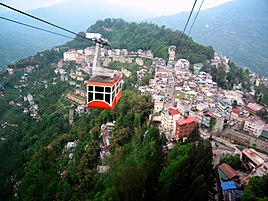
Ropeway, Gangtok 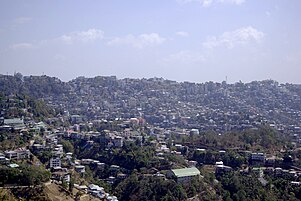
Aizawl, Mizoram 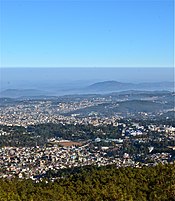
Aerial view of Shillong 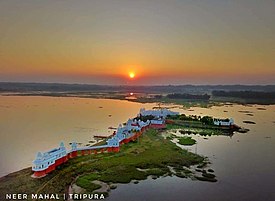
Neer Mahal of Tripura Dzüko Valley (Borders of Nagaland and Manipur) 
Sela Pass, Tawang (Arunachal Pradesh) 
Bhalukpong, Arunachal Pradesh 
Loktak lake, Manipur 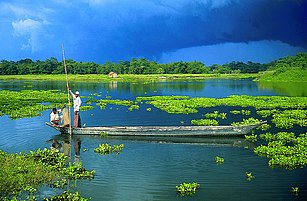
Majuli Island, Assam Nohkalikai Falls, Cherrapunji, Meghalaya
Topography[]
Highest peaks[]
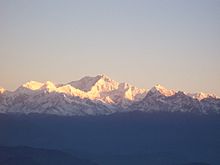
Kangchenjunga, the third highest mountain peak in the world rising to an altitude of 8,586 m (28,169 ft), lies in-between the state Sikkim and adjacent country Nepal.
| Peak | State | Range/Region | Height (m) | Height (ft) | Coordinates |
|---|---|---|---|---|---|
| Kangchenjunga (shared with Nepal) | Sikkim | Eastern Himalaya | 8,586 | 28,169 | 27°42′11″N 88°08′53″E / 27.703°N 88.148°E |
| Kangto (shared with China) | Arunachal Pradesh | Eastern Himalaya | 7,090 | 23,261 | 27°51′54″N 92°31′59″E / 27.865°N 92.533°E |
| Mount Saramati (shared with Myanmar) | Nagaland | Naga Hills section of the Purvanchal Range | 3,841 | 12,602 | 25°44′31″N 95°01′59″E / 25.742°N 95.033°E |
| Mount Tempü (also known as Mount Iso) | Manipur | Naga Hills section of the Purvanchal Range | 2,994 | 9,823 | 25°31′52″N 94°05′06″E / 25.531°N 94.085°E |
| Phawngpui | Mizoram | Lushai Hills section of the Purvanchal Range | 2,165 | 7,103 | 22°37′55″N 93°02′20″E / 22.632°N 93.039°E |
| Meghalaya | Khasi Hills section of the Shillong Plateau | 1,965 | 6,447 | 25°31′55″N 91°51′04″E / 25.532°N 91.851°E | |
| Unnamed peak | Assam | section of the Karbi Anglong Plateau | 1,960 | 6,430 | 25°19′16″N 93°27′11″E / 25.321°N 93.453°E |
| Betlingchhip | Tripura | Jampui Hills section of the Purvanchal Range | 930 | 3,051 | 23°48′36″N 92°15′40″E / 23.810°N 92.261°E |
Brahmaputra River Basin[]

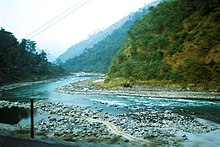
Tributaries of the Brahmaputra River in Northeast India:
- Beki River
- Bhogdoi River
- Dhansiri River
- Dibang River
- Dihing River
- Kameng River
- Kolong
- Kopili River
- Lohit River
- Manas River
- Sankosh River
- Subansiri River
- Teesta River
Climate[]
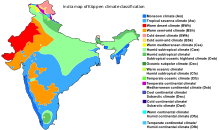
Northeast India has a subtropical climate that is influenced by its relief and influences from the southwest and northeast monsoons.[25][26] The Himalayas to the north, the Meghalaya plateau to the south and the hills of Nagaland, Mizoram and Manipur to the east influences the climate.[27] Since monsoon winds originating from the Bay of Bengal move northeast, these mountains force the moist winds upwards, causing them to cool adiabatically and condense into clouds, releasing heavy precipitation on these slopes.[27] It is the rainiest region in the country, with many places receiving an average annual precipitation of 2,000 mm (79 in), which is mostly concentrated in summer during the monsoon season.[27] Cherrapunji, located on the Meghalaya plateau is one of the rainiest place in the world with an annual precipitation of 11,777 mm (463.7 in).[27] Temperatures are moderate in the Brahmaputra and Barak valley river plains which decreases with altitude in the hilly areas.[27] At the highest altitudes, there is permanent snow cover.[27] In general, the region has 3 seasons: Winter, Summer, and rainy season in which the rainy season coincides with the summer months much like the rest of India.[28] Winter is from early November until mid March while summer is from mid-April to mid-October.[27]
Under the Köppen climate classification, the region is divided into 3 broad types: A (tropical climates), C (warm temperate mesothermal climates), and D (snow microthermal climates).[29][30] The tropical climates are located in parts of Manipur, Tripura, Mizoram, and the Cachar plains south of 25oN and are classified as tropical wet and dry (Aw).[29] Much of Assam, Nagaland, northern parts of Meghalaya and Manipur and parts of Arunachal Pradesh fall within the warm temperature mesothermal climates (type C) where the mean temperatures in coldest months are between −3 to 18 °C (27 to 64 °F).[30][31] The entire Brahmaputra valley has a humid subtropical climate (Cfa/Cwa) with hot summers.[30][31] At altitudes between 500 to 1,500 m (1,600 to 4,900 ft) located in the eastern hills of Nagaland, Manipur and Arunachal Pradesh, a (Cfb/CWb) climate prevails with warm summers.[30][31] Locations above 1,500 m (4,900 ft) in Meghalaya, parts of Nagaland, and northern Arunachal Pradesh have a (Cfc/Cwc) climates with short and cool summers.[31] Finally, the extreme northern parts of Arunachal Pradesh have are classified as humid continental climates with mean winter temperatures below −3 °C (27 °F).[30][32]
- Temperature
Temperatures vary by altitude with the warmest places being in the Brahmaputra and Barak River plains and the coldest at the highest altitudes.[33] It is also influenced by proximity to the sea with the valleys and western areas being close to the sea, which moderates temperatures.[33] Generally, temperatures in the hilly and mountainous areas are generally lower than the plains which lie at a lower altitude.[34] Summer temperatures tend to be more uniform than winter temperatures due to high cloud cover and humidity.[35]
In the Brahmaputra and Barak valley river plains, mean winter temperatures vary between 16 to 17 °C (61 to 63 °F) while mean summer temperatures are around 28 °C (82 °F).[33] The highest summer temperatures occur in the West Tripura plain with Agartala, the capital of Tripura having mean maximum summer temperatures ranging between 33 to 35 °C (91 to 95 °F) in April.[36] The highest temperatures in summer occur before the arrival of monsoons and thus eastern areas have the highest temperatures in June and July where the monsoon arrives later than western areas.[36] In the Cachar Plain, located south of the Brahmaputra plain, temperatures are higher than the Brahmaputra plain although the temperature range is smaller owing to higher cloud cover and the monsoons that moderate night temperatures year round.[36][34]
In the mountainous areas of Arunachal Pradesh, the Himalayan ranges in the northern border with India and China experience the lowest temperatures with heavy snow during winter and temperatures that drop below freezing.[34] Areas with altitudes exceeding 2,000 metres (6,562 ft) receive snowfall during winters and have cool summers.[34] Below 2,000 metres (6,562 ft) above sea level, winter temperatures reach up to 15 °C (59 °F) during the day with nights dropping to zero while summers are cool, with a mean maximum of 25 °C (77 °F) and a mean minimum of 15 °C (59 °F).[34] In the hilly areas of Meghalaya, Nagaland, Manipur and Mizoram, winters are cold while summers are cool.[35]
The plains in Manipur has colder winter minimums than what is warranted by its elevation owing to being surrounded by hills on all sides.[37] This is due to temperature inversions during winter nights when cold air descends from the hills into the valleys below and its geographic location which prevents winds that bring hot temperatures and humidity from coming into the Manipur plain.[37] For example in Imphal, winter daytime temperatures hover around 21 °C (70 °F) but nighttime temperatures drop to 3 °C (37 °F).[37]
- Rainfall
No part of Northeast India receives less than 1,000 mm (39 in) of rainfall a year.[28] Areas in the Brahmputra valley receive 2,000 mm (79 in) of rainfall a year while mountainous areas receive 2,000 to 3,000 mm (79 to 118 in) a year.[28] The southwest monsoon is responsible for bringing 90% of the annual rainfall to the region.[38] April to late October are the months where most of the rainfall in Northeast India occurs with June and July being the rainiest months.[38] In most parts of the region, the average date of onset of the monsoons is 1 June.[39] Southern areas are the first to receive the monsoon (May or June) with the Brahmaputra valley and the mountainous north receiving later (later May or June).[38] In the hilly parts of Mizoram, the closer proximity to the Bay of Bengal causes it to experience early monsoons with June being the wettest season.[38]
High-risk seismic zone[]

The North Eastern Region of India is a mega-earthquake prone zone caused by active fault planes beneath formed by the convergence of three tectonic plates viz. India Plate, Eurasian Plate and Burma Plate. Historically the region has suffered from two great earthquakes (M > 8.0) – 1897 Assam earthquake and 1950 Assam-Tibet earthquake – and about 20 large earthquakes (8.0 > M > 7.0) since 1897.[40][41] The 1950 Assam-Tibet earthquake is still the largest earthquake in India.
Wildlife[]
Flora[]

WWF has identified the entire Eastern Himalayas as a priority Global 200 ecoregion. Conservation International has upscaled the Eastern Himalaya hotspot to include all the eight states of Northeast India, along with the neighbouring countries of Bhutan, southern China and Myanmar.
The region has been identified by the Indian Council of Agricultural Research as a center of rice germplasm. The National Bureau of Plant Genetic Resources (NBPGR), India, has highlighted the region as being rich in wild relatives of crop plants. It is the center of origin of citrus fruits. Two primitive variety of maize, Sikkim Primitive 1 and 2, have been reported from Sikkim (Dhawan, 1964). Although jhum cultivation, a traditional system of agriculture, is often cited as a reason for the loss of forest cover of the region, this primary agricultural economic activity practiced by local tribes supported the cultivation of 35 varieties of crops. The region is rich in medicinal plants and many other rare and endangered taxa. Its high endemism in both higher plants, vertebrates, and avian diversity has qualified it as a biodiversity hotspot.
The following figures highlight the biodiversity significance of the region:[42]
- 51 forest types are found in the region, broadly classified into six major types – tropical moist deciduous forests, tropical semi-evergreen forests, tropical wet evergreen forests, subtropical forests, temperate forests, and alpine forests.
- Out of the nine important vegetation types of India, six are found in the North Eastern Region.
- These forests harbor 8,000 out of 15,000 species of flowering plants. In floral species richness, the highest diversity is reported from the states of Arunachal Pradesh (5000 species) and Sikkim (4500 species) amongst the North Eastern states.
- According to the Indian Red Data Book, published by the Botanical Survey of India, 10 percent of the flowering plants in the country are endangered. Of the 1500 endangered floral species, 800 are reported from Northeast India.
- Most of the North Eastern states have more than 60% of their area under forest cover, a minimum suggested coverage for the hill states in the country in order to protect from erosion.
- Northeast India is a part of Indo-Burma hotspot. This hotspot is the second largest in the world, next only to the Mediterranean Basin, with an area 2,206,000 square kilometres (852,000 sq mi) among the 25 identified.[citation needed]
Fauna[]
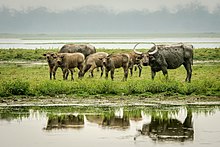
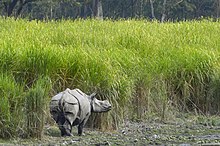
The International Council for Bird Preservation, UK identified the Assam plains and the Eastern Himalaya as an Endemic Bird Area (EBA). The EBA has an area of 220,000 km2 following the Himalayan range in the countries of Bangladesh, Bhutan, China, Nepal, Myanmar and the Indian states of Sikkim, northern West Bengal, Arunachal Pradesh, southern Assam, Nagaland, Manipur, Meghalaya and Mizoram. Because of a southward occurrence of this mountain range in comparison to other Himalayan ranges, this region has a distinctly different climate, with warmer mean temperatures and fewer days with frost, and much higher rainfall. This has resulted in the occurrence of a rich array of restricted-range bird species. More than two critically endangered species, three endangered species, and 14 vulnerable species of birds are in this EBA. Stattersfield et al. (1998) identified 22 restricted range species, out of which 19 are confined to this region and the remaining three are present in other endemic and secondary areas. Eleven of the 22 restricted-range species found in this region are considered as threatened (Birdlife International 2001), a number greater than in any other EBA of India.[citation needed]
Northeast India is very rich in faunal diversity. There are as many as 15 species of non-human primates and most important of them are hoolock gibbon, , pigtailed macaque, golden langur, hanuman langur and rhesus monkey. The most important and endangered species is one-horned rhinoceros. The forests of the region are also the habitats of elephant, royal Bengal tiger, leopard, golden cat, fishing cat, marbled cat, etc. the Gangetic dolphin in the Brahmaputra is also an endangered species. The other endangered species are otter, mugger crocodile, tortoise and some fishes.[43]
WWF has identified the following priority ecoregions in North-East India:
- Brahmaputra Valley semi-evergreen forests
- Eastern Himalayan broadleaf forests
- Eastern Himalayan subalpine conifer forests
- Northeast India–Myanmar pine forests
National Parks[]
| National park | Location | State | Area (km2) | Importance | Vegetation |
|---|---|---|---|---|---|
| Namdapha National Park | Changlang district | Arunachal Pradesh | 1,985 | Largest protected area in Eastern Himalaya | Tropical and subtropical moist broadleaf forests, montane forests |
| Manas National Park | Baksa district | Assam | 950 | UNESCO World Heritage Site | Tropical and subtropical moist broadleaf forests |
| Kaziranga National Park | Golaghat and Nagaon districts | Assam | [44] 882 | UNESCO World Heritage Site | Brahmaputra Valley semi-evergreen forests, Terai–Duar savanna and grasslands |
| Khangchendzonga National Park | North Sikkim district | Sikkim | 850 | UNESCO Mixed World Heritage Site and highest altitude wildlife protected area in India | Sub-tropical to Alpine, Krummholz (stunted forest)[45] |
| Mouling National Park | Upper Siang, West Siang and East Siang districts | Arunachal Pradesh | 483 | Tropical to Temperate forests | |
| Dibru-Saikhowa National Park | Dibrugarh and Tinsukia districts | Assam | 350 | Brahmaputra Valley semi-evergreen forests | |
| Balphakram National Park | South Garo Hills district | Meghalaya | 220 | Sub-tropical evergreen deciduous forests | |
| Intangki National Park | Peren district | Nagaland | 202 | Temperate evergreen forests | |
| Nameri National Park | Sonitpur district | Assam | 200 | Brahmaputra Valley semi-evergreen forests | |
| Murlen National Park | Champhai district | Mizoram | 100 | Montane sub-tropical semi-evergreen forest[46] | |
| Orang National Park | Darrang and Sonitpur | Assam | 79 | Eastern seasonal swamp forests, Eastern Himalayan moist mixed deciduous forests, eastern wet alluvial grasslands[47] | |
| Phawngpui National Park | Lawngtlai district | Mizoram | 50 | Temperate forests[48] | |
| Nokrek National Park | West Garo Hills district | Meghalaya | 48 | Tropical and subtropical moist broadleaf forests | |
| Sirohi National Park | Ukhrul district | Manipur | 41 | Mizoram–Manipur–Kachin rain forests | |
| Keibul Lamjao National Park | Bishnupur district | Manipur | 40 | World's only floating National park | Phumdi (floating marshes) |
| Bison (Rajbari) National Park | South Tripura district | Tripura | 32 | Tropical semi-evergreen and moist deciduous forests | |
| Clouded Leopard National Park | Sepahijala district | Tripura | 5 | Tropical and subtropical moist broadleaf forests |
State Symbols[]
| Arunachal Pradesh | Assam | Manipur | Meghalaya | |||||
|---|---|---|---|---|---|---|---|---|
| Animal | Mithun (Bos frontalis) | Indian rhinoceros (Rhinoceros unicornis) | Sangai (Rucervus eldii eldii) | Clouded leopard (Neofelis nebulosa) | ||||
| Bird | Hornbill (Buceros bicornis) | White-winged duck (Asarcornis scutulata) | Mrs. Hume's pheasant (Syrmaticus humiae) | Hill myna (Gracula religiosa) | ||||
| Flower | Foxtail orchid (Rhynchostylis retusa) | Foxtail orchid (Rhynchostylis retusa) | Siroi lily (Lilium mackliniae) | Lady's Slipper Orchid (Paphiopedilum insigne) | ||||
| Tree | Hollong (Dipterocarpus macrocarpus) | Hollong (Dipterocarpus macrocarpus) | Uningthou (Phoebe hainesiana) | Gamhar (Gmelina arborea) | ||||
| Mizoram | Nagaland | Sikkim | Tripura | |||||
| Animal | Himalayan serow (Capricornis thar) | Mithun (Bos frontalis) | Red panda (Ailurus fulgens) | Phayre's leaf monkey (Trachypithecus phayrei) | ||||
| Bird | Mrs. Hume's pheasant (Syrmaticus humiae) | Blyth's tragopan (Tragopan blythii) | Blood pheasant (Ithaginis cruentus) | Green imperial pigeon (Ducula aenea) | ||||
| Flower | Red Vanda (Renanthera imschootiana) | Tree rhododendron (Rhododendron arboreum) | Noble dendrobium (Dendrobium nobile) | Indian rose chestnut (Mesua ferrea) | ||||
| Tree | Indian rose chestnut (Mesua ferrea) | Alder (Alnus nepalensis) | Rhododendron (Rhododendron niveum) | Agarwood (Aquillaria agallocha) | ||||
Demographics[]
The total population of Northeast India is 46 million with 68 percent of that living in Assam alone. Assam also has a higher population density of 397 persons per km2 than the national average of 382 persons per km2. The literacy rates in the states of the Northeastern region, except those in Arunachal Pradesh and Assam, are higher than the national average of 74 percent. As per 2011 census, Meghalaya recorded the highest population growth of 27.8 percent among all the states of the region, higher than the national average at 17.64 percent; while Nagaland recorded the lowest in the entire country with a negative 0.5 percent.[49]
| State | Population | Males | Females | Sex Ratio | Literacy % | Rural Population | Urban Population | Area (km2) | Density (/km2) |
|---|---|---|---|---|---|---|---|---|---|
| Arunachal Pradesh | 1,383,727 | 713,912 | 669,815 | 938 | 65.38 | 870,087 | 227,881 | 83,743 | 17 |
| Assam | 31,205,576 | 15,939,443 | 15,266,133 | 958 | 72.19 | 23,216,288 | 3,439,240 | 78,438 | 397 |
| Manipur | 2,570,390 | 1,290,171 | 1,280,219 | 992 | 79.21 | 1,590,820 | 575,968 | 22,327 | 122 |
| Meghalaya | 2,966,889 | 1,491,832 | 1,475,057 | 989 | 74.43 | 1,864,711 | 454,111 | 22,429 | 132 |
| Mizoram | 1,097,206 | 555,339 | 541,867 | 976 | 91.33 | 447,567 | 441,006 | 21,081 | 52 |
| Nagaland | 1,978,502 | 1,024,649 | 953,853 | 931 | 79.55 | 1,647,249 | 342,787 | 16,579 | 119 |
| Sikkim | 610,577 | 323,070 | 287,507 | 890 | 81.42 | 480,981 | 59,870 | 7,096 | 86 |
| Tripura | 3,673,917 | 2,087,059 | 2,086,858 | 960 | 91.58 | 2,639,134 | 1,534,783 | 10,486 | 350 |
Largest cities by population[]
According to 2011 Census of India, the largest cities in Northeast India are
| Rank | City | Type | State | Population | Rank | City | Type | State | Population |
|---|---|---|---|---|---|---|---|---|---|
| 1 | Guwahati | City | Assam | 968,549 | 9 | Jorhat | UA | Assam | 153,889 |
| 2 | Agartala | City | Tripura | 622,613 | 10 | Nagaon | UA | Assam | 147,496 |
| 3 | Imphal | UA | Manipur | 414,288 | 11 | Bongaigaon | UA | Assam | 139,650 |
| 4 | Dimapur | City | Nagaland | 379,769 | 12 | Tinsukia | UA | Assam | 126,389 |
| 5 | Shillong | UA | Meghalaya | 354,325 | 13 | Tezpur | UA | Assam | 102,505 |
| 6 | Aizawl | City | Mizoram | 291,822 | 14 | Kohima | UA | Nagaland | 100,000 |
| 7 | Silchar | UA | Assam | 229,136 | 15 | Gangtok | City | Sikkim | 98,658 |
| 8 | Dibrugarh | UA | Assam | 154,296 | 16 | Itanagar | City | Arunachal Pradesh | 95,650 |
|
UA: Urban Agglomeration[50] | |||||||||
Languages[]
Northeast India constitutes a single linguistic region within the Indian national context, with about 220 languages in multiple language families (Indo-European, Sino-Tibetan, Kra–Dai, Austroasiatic, as well as some creole languages) that share a number of features that set them apart from most other areas of the Indian subcontinent (such as alveolar consonants rather than the more typical dental/retroflex distinction).[51][52] Assamese, an Indo-Aryan language spoken mostly in the Brahmaputra Valley, developed as a lingua franca for many speech communities. Assamese-based pidgin/creoles have developed in Nagaland (Nagamese) and Arunachal (Nefamese),[53] though Nefamese has been replaced by Hindi in recent times. The Austro-Asiatic family is represented by the Khasi, Jaintia and War languages of Meghalaya. A small number of Tai–Kadai languages (Ahom, Tai Phake, Khamti, etc.) are also spoken. Sino-Tibetan is represented by a number of languages that differ significantly from each other,[54] some of which are: Boro, Rabha, Karbi, Mising, Tiwa, Deori, Biate etc. (Assam); Garo, Hajong, Biate (Meghalaya) Ao, Angami, Sema, Lotha, Konyak etc.(Nagaland); Mizo, Hmar , Paite , etc. (Mizoram); Hrusso, Tanee, Nisi, Adi, Abor, Nocte, Apatani, Misimi etc. (Arunachal). Meitei is the official language in Manipur, the dominant language of the Imphal Valley; while "Naga" languages such as Poumai, Mao, Maram, Rongmei (Kabui) and Tangkul, and Kuki-Chin languages such as Thadou-Kuki, Mizo, Paite, Simte and Hmar predominate in individual hill areas of the state.[55]
Among other Indo-Aryan languages, Sylheti is spoken in South Assam in the Barak Valley where Bengali is official language. Chakma is also a Indo-Aryan language spoken in Mizoram. Besides the Sino-Tibetan Tripuri language, Bengali is a majority language in Tripura. Nepali, an Indo-Aryan language, is dominant in Sikkim, besides the Sino-Tibetan languages Limbu, Bhutia and Lepcha. Bengali was made the official language of Colonial Assam for about forty years from the 1830s.
Official languages[]
| State | Official Languages[56] |
|---|---|
| Arunachal Pradesh | English |
| Assam | Assamese, Bengali (in the Barak Valley), Bodo (in Bodoland) |
| Manipur | Meiteilon |
| Meghalaya | Khasi, Garo, English |
| Mizoram | Mizo, English |
| Nagaland | English[57] |
| Sikkim | Nepali, English |
| Tripura | Tripuri, Bengali, English[58] |
Etymology of state names[]
| Name of state | Origin | Literal meaning |
|---|---|---|
| Arunachal Pradesh | Sanskrit | Land of the rising sun |
| Assam | Native word | Name derived from the Ahom people[59] |
| Manipur | Sanskrit | Land abundant with jewels, adopted in the 18th century |
| Meghalaya | Sanskrit | Abode of the clouds, coined by Shiba P. Chatterjee |
| Mizoram | Mizo language | Land of the Hilly people; Ram - means land |
| Nagaland | English | Land of the Naga people |
| Sikkim | Limbu Language | New House – Derived from the word "Sukhim", "Su" meaning new and "Khim" meaning house |
| Tripura | Kokborok | Sanskrit version of native names: Tipra, Tuipura, Twipra etc. It literally means Land near the Water – Derived from the word "TWIPRA", "Twi" meaning water and "Bupra" meaning near. As Tripura is slightly near the Bay of Bengal |
Endangered languages[]
Given the diverse population in the region with only a few widely spoken ones recognised as the official languages by both the state and central governments, a large number of languages from the North Eastern Region of India have become vulnerable. Without proper teaching and preservation efforts, the already underdeveloped literature of the endangered languages are on the verge of extinction. Additionally, the younger generation are rapidly adopting the widely spoken languages to secure employment and livelihood.[60]
Religions[]
Religion in Northeast India (2011)
| State | Hinduism | Islam | Christianity | Buddhism | Jainism | Sikhism | Other Religions | Religion Not Stated |
|---|---|---|---|---|---|---|---|---|
| Arunachal Pradesh | 401,876 | 27,045 | 418,732 | 162,815 | 771 | 3,287 | 362,553 | 6,648 |
| Assam | 19,180,759 | 10,679,345 | 1,165,867 | 54,993 | 25,949 | 20,672 | 27,118 | 50,873 |
| Manipur | 1,181,876 | 239,836 | 1,179,043 | 7,084 | 1,692 | 1,527 | 233,767 | 10,969 |
| Meghalaya | 342,078 | 130,399 | 2,213,027 | 9,864 | 627 | 3,045 | 258,271 | 9,578 |
| Mizoram | 30,136 | 14,832 | 956,331 | 93,411 | 376 | 286 | 808 | 1,026 |
| Nagaland | 173,054 | 48,963 | 1,739,651 | 6,759 | 2,655 | 1,890 | 3,214 | 2,316 |
| Sikkim | 352,662 | 9,867 | 60,522 | 167,216 | 314 | 1,868 | 16,300 | 1,828 |
| Tripura | 3,063,903 | 316,042 | 159,882 | 125,385 | 860 | 1,070 | 1,514 | 5,261 |
| Total | 24,726,344 | 11,466,329 | 7,893,055 | 627,527 | 33,244 | 33,645 | 903,545 | 88,499 |
Ethnic groups[]
Northeast India has over 220 ethnic groups and an equal number of dialects in which Bodo form the largest indigenous ethnic group.[62] The hills states in the region like Arunachal Pradesh, Meghalaya, Mizoram, and Nagaland are predominantly inhabited by tribal people with a degree of diversity even within the tribal groups. The region's population results from ancient and continuous flows of migrations from Tibet, Indo-Gangetic India, the Himalayas, present Bangladesh, and Myanmar.[63]
Major communities[]
- Ao Naga
- Adivasi
- Apatani
- Assamese
- Bengali
- Bhojpuri
- Bhutia
- Bishnupriya
- Biate
- Bodo
- Chakhesang
- Chakma
- Deori
- Dimasa
- Garo
- Hajong
- Hmar
- Karbi
- Kami
- Khasi
- Kirati
- Khampti
- Kom
- Kuki
- Lepcha
- Limbu
- Meitei (Manipuri)
- Mishing
- Miyas
- Mizo
- Mara
- Mishmi
- Naga
- Nepali
- Paite
- Pnar
- Purvottar maithili
- Rabha
- Ranglong (Langrong)
- Singpho
- Sylheti
- Tamang
- Tiwa
- Tripuri
- Yimchunger
- Zomi people (Paite, Vaiphei, Zou, Teddim, Simte, Gangte)

British India map of Northeast India by ethnicity, 1891 A Naga warrior in 1960 
Bishnupuriya bride 
Shad suk Mynsiem, a Khasi festival 
Traditional Hajong Clothing 
Aka tribe, Arunachal Pradesh 
Mizo school girls Women selling fruits in Senapati, Manipur 
Princess of Sikkim in traditional royal dress 
Tripuri woman in traditional attire 
Asamiya youth in Bihu attire.


Culture[]
Cuisines[]
| State | Staple diet | Popular dishes | Related article |
|---|---|---|---|
| Arunachal Pradesh | Rice, fish, meat, leaf vegetables | Thukpa, momo, apong (rice beer) | Cuisine of Arunachal Pradesh |
| Assam | Rice, fish, meat, leaf vegetable | Assam tea, Pitha (rice cakes), Khar (alkali), Khar-Matidail, Ou-tenga-Maasor-Jul, Pura-Maas, Alu-Pitika, Pani-Tenga, Kharoli, Khorisa (bamboo shoot), Xukan Maasor Xukoti, Pointa-Bhaat, Tupula-Bhaat, Sunga-Sawul (rice cooked in bamboo), Kharikat Diya Maas, Kharikat Dia-Mangxo, Pati-Hanhor-Mangxo-Jul (duck stew), Lai-Xak-Gahori-Mangxo (pork with mustard greens), Kumol Sawul-Doi Jolpaan, Tamul (betel nut) – paan, rice beer () | Assamese cuisine |
| Manipur | Rice, fish, local vegetables | Eromba, u-morok, singju, ngari (fermented fish), kangshoi | Cuisine of Manipur |
| Meghalaya | Rice, spiced meat, fish | Khasi dishes - Thungtap, Dohjem, Thungrumbai, Jadoh, ki kpu, Garo dishes - kappa, brenga, so•tepa, wa•tepa, pura, minil, na•kam (dried fish), momo, bamboo shoot | Cuisine of Meghalaya |
| Mizoram | Rice, fish, meat | Bai, bekang (fermented soya beans), sa-um (fermented pork), sawhchiar | |
| Nagaland | Rice, meat, stewed or steamed vegetables | fermented bamboo shoot, smoked pork and beef, axone, bhut jolokia | Naga cuisine |
| Sikkim | Rice, meat, dairy products | Thukpa, momo, sha Phaley, gundruk, sinki, sel roti | Sikkimese cuisine |
| Tripura | Mai(Rice), Aa(fish), Muihan(meat), Sikamuk/Kakamuk(eadible Snails), Sindai(Oysters), local
Vegetables |
Maidul(Rice ball), Bangwi, awang sokrang, Chakhūi, Gudok, Mosdeng, Awandru, Mūkhūi, Hangjak, Yikjak, Wahan mosdeng, , Berma (fermented fish) | Tripuri cuisine |
Bhangui - Tripuri food of Tripura Paknam (Manipur) 
Basic Tripuri lunch thali Smoked freshwater fish (Manipur) 
Thukpa - a popular Northeast India cuisine North Sikkim meal Assamese thali 
Red rice with pork (Arunachal Pradesh)
Arts[]
Sattriya (from Assam) and Manipuri dance (from Manipur) have been listed as classical dances of India. Besides these, all tribes in Northeast India have their own folk dances associated with their religion and festivals. The tribal heritage in the region is rich with the practice of hunting, land cultivation and indigenous crafts. The rich culture is vibrant and visible with the traditional attires of each community.[citation needed]
All states in Northeast India share the handicrafts of bamboo and cane, wood carving, making traditional weapons and musical instruments, pottery and handloom weaving. Traditional tribal attires are made of thick fabrics primarily with cotton.[64] Assam silk is a famous industry in the region.
| State | Traditional Performing Arts | Traditional Visual Arts | Traditional Crafts |
|---|---|---|---|
| Arunachal Pradesh | Wancho dances, Idu Mishmi dance, Digaru Mishmi Buiya dance, Khampti dance, Ponung dance, Sadinuktso[65] | Cane and bamboo, cotton and wool weaving, wood carving, blacksmithy (hand tools, weapons, ornaments, dishes, sacred bells and smoking pipes)[65][66] | |
| Assam | Sattriya, Bagurumba, Bihu dance, Bhaona (For more see Music of Assam) | Hastividyarnava (For more see Fine Arts of Assam) | Cane and bamboo, bell metal and brass, silk, toy and mask making, pottery and terracotta, jewellery, musical instruments making, boat making, paints |
| Manipur | Manipuri dance (Ras Lila), Kartal Cholom, Manjira Cholom, Khubak Eshei, Pung Cholom, Lai-Haraoba | Cotton textile, bamboo crafts (hats, baskets), pottery[66][64] | |
| Meghalaya | Nongkrem, Shad suk, Behdienkhlam, Wangala, Lahoo dance[67][66] (For more see Music of Meghalaya) | Making hand tools and weapons, musical instruments (drums), cane and bamboo work, weaving traditional attires, jewellery making (gold, coral, glass), wall engravings, wood carving[66][68] | |
| Mizoram | Cheraw, Khuallam, Chheih-Lam, Chai, Rallu-Lam, Sawlakia, Sarlamkai, Par-lam, Sakei Lu Lam[69] (For more see Music of Mizoram) | Traditional hand tools, weapons and textile work, bamboo and cane handicrafts[70][66] | |
| Nagaland | Zeliang dance, war dance, Nruirolians (cock dance) (For more see Music of Nagaland) | Cane and bamboo crafts, traditional hand tools, weapons and textile work, wood carving, pottery, ornaments for traditional attire, musical instruments (drum and trumpet)[66] | |
| Sikkim | Chu Faat dance, Lu Khangthamo, Gha To Kito, Rechungma, Maruni, Tamang Selo, Singhi Chaam, Yak Chaam, Khukuri dance, Rumtek Chaam (mask dance)[71][72][73] (See also Music of Sikkim) | Thangka (showcasing Buddhist teachings on cotton canvas using vegetable dyes)[72] | Handmade paper, carpet making, woollen textile, wood carving[72] |
| Tripura | Goria dance, Jhum dance, Lebang dance, Mamita dance, Mosak sulmani dance, Hojagiri dance, Bizhu dance, Wangala, Hai-hak dance, Sangrai dance, Owa dance | Rock curbings of different gods and goddesses | Cane and bamboo, Traditional cotton textiles, weaving and handloom, moluwa /sitalpati(mat making), wood carving,[66] string and wind musical instruments |
Click on this site for Tripuri Traditional dances. https://en.m.wikipedia.org/wiki/Tripuri_dances
Sattriya dance (Assam) 
Assamese youths performing Bihu dance.
Nyokum festival of Nyishi tribe (Arunachal Pradesh) 
Manipuri dance 
Bagurumba dance of Bodo tribe (Assam) Wangala dance of Garo tribe (Assam, Meghalaya) 
Dance of Angami tribe (Nagaland) 
Students performing traditional dance at Jorethang (Sikkim)
Music[]
Northeast is a hub of different genres of music. Each community has its own rich heritage of folk music. Talented musicians and singers are plentifully found in this part of the country. The Assamese singer-composer Bhupen Hazarika achieved national and international fame with his remarkable creations. Another famous singer from Assam, Pratima Barua Pandey is a well-known folk singer. Zubeen Garg, Papon, Anurag Saikia are some other notable singers, musicians from the state of Assam. Tangkhul Naga folk blue singer like Rewben Mashangva, who comes from Ukhrul, is an acclaimed Folk singer whose music is inspired by the like of Bob Dylan and Bob Marley. Another famous folk singing band from Nagaland popularly known as Tetseo Sisters is one to be noted for their original music genre. However, younger generation has started pursuing western music more and more nowadays. Northeast is witnessing immense rise of musical revolution in the 21st century.[citation needed]
Literature[]
Many of the Northeast Indian indigenous communities have an ancient heritage of folktales which tell the tale of their origin, rituals, beliefs and so on. These tales are transmitted from one generation to another in oral form. They are remarkable instances of tribal wisdom and imagination. However, Assam, Tripura and Manipur have some ancient written texts. These states were mentioned in the great Hindu epic Mahabharata. The Saptakanda Ramayana in Assamese by Madhava Kandali is considered the first translation of the Sanskrit Ramayana into a modern Indo-Aryan Language. Karbi Ramayana bears witness to the old heritage of written literature in Assam. Two writers from the Northeast, viz., Birendra Kumar Bhattacharya and Mamoni Raisom Goswami, have been awarded Jnanpith, the highest literary award in India.[74] Hence, Birendra Kumar Bhattacharya was the first Assamese writer and from the Northeast India to receive Jnanpith Award for his Assamese novel Mrityunjay(1979).[75] Mamoni Raisom Goswami was awarded the Jnanpith Award in the year 2000.[74] Nagen Saikia is the first writer from Assam and the Northeast India, to have been conferred the Sahitya Akademi Fellowship by the Sahitya Akademi.[76][77] The last quarter of the 20th century saw the rise of modern literature in the Northeast. Most of the writers, especially the tribal writers, are bilingual, that is, they write both in their mother-tongue and English. Some of the general features of this literature are—retrieval of folklore, celebration of folk culture, identity politics, reaction to the insurgency and counter-insurgency operations, depiction of natural beauty, changes meted out by time, etc. The major writers of Northeast Literature are--(from Assam) Lakshminath Bezbaroa, Homen Borgohain, Birendra Kumar Bhattacharya, Harekrishna Deka, Rongbong Terang, Nilmani Phukan, Indira Goswami, Hiren Bhattacharyya, Mitra Phukan, Jahnavi Barua, Dhruba Hazarika, Rita Chowdhury, D N Bezbarua, Nilim Kumar, Anupama Basumatary, Uddipana Goswami, Aruni Kashyap; (from Arunachal Pradesh) Mamang Dai; (from Manipur) Robin S Ngangom, Ratan Thiyam, Thangjam Ibopishak, Gambhini Devi, T Bijoykumar Singh; (from Meghalaya) Kynpham Sing Nongkynrih, Esther Syiem, Desmond Kharmawphlang, Paul Lyngdoh, Anjum Hassan; (from Mizoram) Mona Zote; (from Nagaland) Temsula Ao, Cherrie Chhangte, Easterine Kire; (from Sikkim) Sudha M Rai, Rajendra Bhandari (from Tripura) Chandrakanta Murasingh. Temsula Ao is the first writer from Northeast India to be awarded the Sahitya Akademi Award (2013) in the Indian English Literature category for her collection of short stories, Laburnum for My Head, and Padmashree (2007). Easterine Kire is the first English novelist hailed from Nagaland. She received The Hindu Literary Prize (2015) for her novel When the River Sleeps. Indira Goswami, alias Mamoni Roisom Goswami, is an acclaimed Assamese writer whose novels include Moth-Eaten Howda of the Tusker, Pages Stained with Blood, The Shadow of Kamakhya and The Blue-Necked God. Mamang Dai won the Sahitya Akademi Award (2017) for her novel The Black Hill.[78]
Festivals[]
Indigenous festivals in the northeast include the Ojiale festival of the Wancho people, Chhekar festival of the Sherdukpen people, Longte Yullo festival of Nishis, Solung festival of Adis, Losar festival of Monpas, Reh festival of Idu Mishmis and Dree festival of Apatani. Mamita Tripurabda(Tring festival), Buisu , Hangrai, Hojagiri , Kharchi and Garia festivals of Tripura, [79] In Manipur popular festivals include Ningol Chakouba and the Manipur boat racing festival or the Heikru Hidongba.
Administration and political disputes[]
International borders management[]
- McMahon Line and China–India border crossings manned by Indo-Tibetan Border Police and Special Frontier Force with China along Sikkim and Arunachal Pradesh
- India-Bangladesh border and crossings manned by Border Security Force along Assam, Meghalaya, Tripura and Mizoram
- India–Myanmar border, crossings manned by Assam Rifles and Indian Army along Arunachal Pradesh, Nagaland, Manipur and Mizoram
- India-Bhutan borders manned by Sashastra Seema Bal along Sikkim, Assam and Arunachal Pradesh
- India-Nepal border manned by Sashastra Seema Bal along Sikkim
Pan-states development authorities[]
- Ministry for Development of North Eastern Region (DoNER)
- North Eastern Council
States and sub-divisions[]
| State | Code | Capital | Districts | Sub-division Type | Number of Subdivisions |
|---|---|---|---|---|---|
| Arunachal Pradesh | IN-AR | Itanagar | 20 | Circle | 149 |
| Assam | IN-AS | Dispur | 33 | Sub-division | 78 |
| Manipur | IN-MN | Imphal | 16 | Sub-division | 38 |
| Meghalaya | IN-ML | Shillong | 11 | Community Development Block | 39 |
| Mizoram | IN-MZ | Aizawl | 8 | Community Development Block | 22 |
| Nagaland | IN-NL | Kohima | 11 | Circle | 33 |
| Sikkim | IN-SK | Gangtok | 4 | Sub-division | 9 |
| Tripura | IN-TR | Agartala | 8 | Sub-division | 23 |
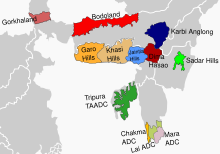
| State | Autonomous Division | Establishment |
|---|---|---|
| Assam | Bodoland Territorial Area Districts | February 2003 |
| Dima Hasao district | February 1970 | |
| Karbi Anglong district | February 1970 | |
| Mising Autonomous Council | 1995 | |
| Rabha Hasong Autonomous Council | 1995 | |
| Manipur[80][81] | Churachandpur Autonomous District Council | 1971 |
| Chandel Autonomous District Council | 1971 | |
| Senapati Autonomous District Council | 1971 | |
| Sadar Hills Autonomous District Council | 1971 | |
| Tamenglong Autonomous District Council | 1971 | |
| Ukhrul Autonomous District Council | 1971 | |
| Meghalaya | Garo Hills Autonomous District Council | |
| Jaintia Hills Autonomous District Council | July 2012 | |
| Khasi Hills Autonomous District Council | ||
| Mizoram | Chakma Autonomous District Council | April 1972 |
| Lai Autonomous District Council | April 1972 | |
| Mara Autonomous District Council | May 1971 | |
| Tripura | Tripura Tribal Areas Autonomous District Council | January 1982 |
Government[]
The northeastern states, having 3.8% of India's total population, are allotted 25 out of a total of 543 seats in the Lok Sabha. This is 4.6% of the total number of seats.[citation needed]
| State | Chief Minister[82] | Governor[83] | High Court | Chief Justice |
|---|---|---|---|---|
| Arunachal Pradesh | Pema Khandu | B. D. Mishra | Guwahati High Court (Itanagar Bench) | Shri Ajai Lamba, Chief Justice |
| Assam | Himanta Biswa Sarma | Professor Jagdish Mukhi | Guwahati High Court | Shri Ajai Lamba, Chief Justice |
| Manipur | Nongthombam Biren Singh | Najma Heptulla | Manipur High Court | Justice N. Kotiswar Singh |
| Meghalaya | Conrad Sangma | Shri Ravindra Narayana Ravi | Meghalaya High Court | Justice Dinesh Maheshwari |
| Mizoram | Zoramthanga | Shri P.S. Sreedharan Pillai | Guwahati High Court (Aizawl Bench) | Shri Ajai Lamba, Chief Justice |
| Nagaland | Neiphiu Rio | Shri R. N. Ravi | Guwahati High Court (Kohima Bench) | Shri Ajai Lamba, Chief Justice |
| Sikkim | Prem Singh Tamang | Ganga Prasad | Sikkim High Court | Justice Satish K. Agnihotri |
| Tripura | Biplab Kumar Deb | Shri Ramesh Bais | Tripura High Court | Justice Tinlianthang Vaiphei |
20th century separatist unrest[]
In 1947 Indian independence and partition resulted in the North East becoming a landlocked region. This exacerbated the isolation that has been recognized, but not studied. East Pakistan controlled access to the Indian Ocean.[84] The mountainous terrain has hampered the construction of road and railways connections in the region.[citation needed]
Several militant groups have formed an alliance to fight against the governments of India, Bhutan, and Myanmar, and now use the term "Western Southeast Asia" (WESEA) to refer to the region.[85] The separatist groups include the Kangleipak Communist Party (KCP), Kanglei Yawol Kanna Lup (KYKL), People's Revolutionary Party of Kangleipak (PREPAK), People's Revolutionary Party of Kangleipak-Pro (PREPAK-Pro), Revolutionary People's Front (RPF) and United National Liberation Front (UNLF) of Manipur, Hynniewtrep National Liberation Council (HNLC) of Meghalaya, Kamatapur Liberation Organization (KLO), which operates in Assam and North Bengal, National Democratic Front of Bodoland and ULFA of Assam, and the National Liberation Front of Tripura (NLFT).[86]
Economy[]
The Ministry of Development of North Eastern Region (MDoNER) is the deciding body under Government of India for socio-economic development in the region. The North Eastern Council under MDoNER serves as the regional governing body for Northeast India. The North Eastern Development Finance Corporation Ltd. (NEDFi) is a Public Limited Company providing assistance to micro, small, medium and large enterprises within the northeastern region (NER). Other organizations under MDoNER include North Eastern Regional Agricultural Marketing Corporation Limited (NERAMAC), Sikkim Mining Corporation Limited (SMC) and North Eastern Handlooms and Handicrafts Development Corporation (NEHHDC).
Industries[]
Agriculture[]
The economy is agrarian. Little land is available for settled agriculture. Along with settled agriculture, jhum (slash-and-burn) cultivation is still practised by a few indigenous groups of people. The inaccessible terrain and internal disturbances has made rapid industrialisation difficult in the region.[citation needed]

Jhum cultivation 
Tea garden in Darrang, Assam 
Paddy fields in Manipur 
Oil palm plantation in Mizoram 
Terrace farming in Nagaland 
Local vegetables in Assam
Tourism[]
Living Root Bridges

Northeast India is also the home of many Living root bridges. In Meghalaya, these can be found in the southern Khasi and Jaintia Hills.[87][88][89] They are still widespread in the region, though as a practice they are fading out, with many examples having been destroyed in floods or replaced by more standard structures in recent years.[90] Living root bridges have also been observed in the state of Nagaland, near the Indo-Myanmar border.[91]
Newspapers and Magazines[]
Northeast India has several newspapers in both English and regional languages. The largest circulated English daily in Assam is The Assam Tribune. In Meghalaya, The Shillong Times is the highest circulated newspaper. In Nagaland, Nagaland Post has the highest number of readers. G Plus is the only print and digital English weekly tabloid published from Guwahati. In Manipur, Imphal Free Press is a highly respected newspaper. In Arunachal Pradesh, The Arunachal Times is the highest circulated newspaper in Arunachal Pradesh.[citation needed]
Transportation[]
Air[]

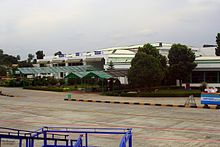
States in the North Eastern Region are well connected by air-transport conducting regular flights to all major cities in the country. The states also own several small airstrips for military and private purposes which may be accessed using Pawan Hans helicopter services. The region currently has two international airports viz. Lokapriya Gopinath Bordoloi International Airport, Bir Tikendrajit International Airport Maharaja Bir Bikram Airport conducting flights to Thailand, Myanmar, Nepal and Bhutan. While the airport in Sikkim is under-construction, Bagdogra Airport (IATA: IXB, ICAO: VEBD) remains the closest domestic airport to the state.
| State | Airport | City | IATA Code |
|---|---|---|---|
| Arunachal Pradesh | Itanagar Airport (Under construction) | Itanagar | |
| Assam | Dibrugarh Airport | Dibrugarh | DIB |
| Jorhat Airport | Jorhat | JRH | |
| Lokpriya Gopinath Bordoloi International Airport | Guwahati | GAU | |
| Lilabari Airport | Lakhimpur | IXI | |
| Rupsi Airport | Dhubri | RUP | |
| Silchar Airport | Silchar | IXS | |
| Tezpur Airport | Tezpur | TEZ | |
| Manipur | Bir Tikendrajit International Airport | Imphal | IMF |
| Meghalaya | Baljek Airport | Tura | VETU (ICAO) |
| Shillong Airport | Shillong | SHL | |
| Mizoram | Lengpui Airport | Aizawl | AJL |
| Nagaland | Dimapur Airport | Dimapur | DMU |
| Sikkim | Pakyong Airport | Gangtok | PYG |
| Tripura | Maharaja Bir Bikram Airport | Agartala | IXA |
Railway[]
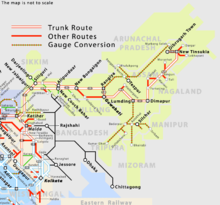
Railway in Northeast India is delineated as Northeast Frontier Railway zone of Indian Railways. The regional network is underdeveloped with the states of Manipur, Meghalaya, Mizoram and Sikkim remaining almost disconnected till date (11 June 2017). However, projects are underway to extend the network and connect all the capital cities in the region.[citation needed]
Look East Policy[]

In the 21st century, there has been recognition among policymakers and economists of the region that the main stumbling block for economic development of the Northeastern region is the disadvantageous geographical location.[92] It was argued that globalisation propagates deterritorialisation and a borderless world which is often associated with economic integration. With 98 percent of its borders with China, Myanmar, Bhutan, Bangladesh and Nepal, Northeast India appears to have a better scope for development in the era of globalisation.[93] As a result, a new policy developed among intellectuals and politicians that one direction the Northeastern region must be looking to as a new way of development lies with political integration with the rest of India and economic integration with the rest of Asia and Oceania, with North, East and Southeast Asia, Micronesia and Polynesia in particular, as the policy of economic integration with the rest of India did not yield much dividends. With the development of this new policy, the Government of India directed its Look East policy towards developing the Northeastern region. This policy is reflected in the Year End Review 2004 of the Ministry of External Affairs, which stated that: "India’s Look East Policy has now been given a new dimension by the UPA Government. India is now looking towards a partnership with the Association of Southeast Asian Nations ASEAN countries, both within BIMSTEC and the India-ASEAN Summit dialogue as integrally linked to economic and security interests, particularly for India’s East and North East region."[94]
Development and connectivity projects[]
The north-east (NE) region of India lags behind the rest of the country in several development indicators. Although infrastructure has developed over the years, the region has to go a long way to level up the national standard. The total road network of about 377 thousand km of NE contributes about 9.94 per cent of the total roads in the country. Road density in terms of road length per thousand km2. area is very poor in hilly state of Arunachal Pradesh, Mizoram, Meghalaya and Sikkim, while it is significantly high in Tripura and Assam. The road length per 100 km2 area in NE districts varies from as less as below 10 km (in Arunachal Pradesh) to more than 200 km (in Tripura). Other means of transport such as rail, air and water is insignificant in NE (except Assam); however, a few cities of these states having direct air connectivity in the region. The total railway network in the NE is 2,602 km (as on 2011), which is only about 4 per cent of the total rail network of the country. Constructions of roads build the road map for development and road is the only means of mass transport for the entire NE of India. Due to hilly terrain and varied altitudes, rail transport is mainly confined to Assam and water transport is almost non-existent.
India's road network has benefited greatly from the articulation of the National Highways Development Project (NHDP). The Ministry has formulated the Special Accelerated Road Development Programme for North East (SARDP-NE) for the development/improvement of more than 10,000 km roads in the NE states. The Ministry of Road Transport and Highways (MoRTH) has been paying special attention to the development of national highways in the region and has assigned 10 per cent of the total allocation of fund for the NE region.
Another major constraint of surface infrastructure projects in the NE states has to be linked up with parallel developments in the neighboring countries, particularly with Bangladesh. The restoration and extension of pre-partition land and river transit routes through Bangladesh is vital for transport infrastructure in NE states. Other international cooperation, such as, revival of Ledo road (Stilwell road) connecting Ledo in Assam to northern Myanmar and extended up to Kunming in south-eastern China, Kaladan Multimodal Transit Project and Trans-Asian Railways, could open up an eastern window for the land-locked NE states of India. Various regional initiatives, such as, the Bangladesh–China–India–Myanmar (BCIM) and Bay of Bengal Initiative for Multi-Sectoral Technical and Economic Cooperation (BIMSTEC), India–Myanmar–Thailand Trilateral Highway (IMTTH) project to link the markets of South and Southeast Asia, are in very initial stages.[95]
- NE road, rail, air services, water, power, and tourism projects
- Look-East connectivity projects with ASEAN and SAARC
See also[]
- Battle of the Tennis Court
- Laskar Committee Report
- Ledo Road (Stillwell Road)
- List of Christian denominations in Northeast India
- Literature from North East India
- Political integration of India
- History of Ladakh
- List of indigenous peoples of South Asia
References[]
Citations[]
- ^ "Indian cities by population" (PDF).
- ^ Jump up to: a b "North Eastern Council". Archived from the original on 15 April 2012. Retrieved 25 March 2012.
- ^ "Problems of border areas in Northeast India" (PDF).
- ^ Jump up to: a b "Integration of Sikkim in North Eastern Council". The Times of India. 10 December 2002. Archived from the original on 30 April 2013. Retrieved 25 March 2012.
- ^ "Evaluation of NEC funded projects in Sikkim" (PDF). NEC. Archived from the original (PDF) on 8 September 2017. Retrieved 4 June 2017.
- ^ Geography of Assam. New Delhi: Rajesh Publications. 2001. p. 12. ISBN 81-85891-41-9. OCLC 47208764.
The first group of migrants to settle in this part of the country is perhaps the Austro-Asiatic language speaking people who came here from South-East Asia a few millennia before Christ. The second group of migrants came to Assam from the north, north-east and east. They are mostly the Tibeto-Burman language speaking people. From about the fifth century before Christ, there started a trickle of migration of the people speaking Indo-Aryan language from the Gangetic plain.
- ^ Hazarika, M. 2006 "Neolithic Culture of Northeast India: A Recent Perspective on the Origins of Pottery and Agriculture." Ancient Asia, 1, doi:10.5334/aa.06104
- ^ "Chang K'ien had clearly realized the existence of a trade route between Sichuan and India via Yunnan and Burma or Assam" (Lahiri 1991, pp. 11–12)
- ^ Besatae in the Schoff translation and also sometimes used by Ptolemy, they are a people similar to Kirradai and they lived in the region between "Assam and Sichuan" (Casson 1989, pp. 214–242)
- ^ (Casson 1989, pp. 51–53)
- ^ "The Periplus of the Erythraen Sea (last quarter of the first century CE) and Ptolemy's Geography (middle of the second century CE) appear to call the land including Assam Kirrhadia after its Kirata population." (Sircar 1990:60–61)
- ^ (Watters 1905, p. 186)
- ^ Mukherjee, Rila (2011). Pelagic Passageways: The Northern Bay of Bengal Before Colonialism. Primus Books. p. 147. ISBN 978-93-80607-20-7.
- ^ Baruah, Sanjib (2004), Between South and Southeast Asia Northeast India and Look East Policy, Ceniseas Paper 4, Guwahati
- ^ "Formation of Assam during British rule in India". Retrieved 25 March 2012.
- ^ "Formation of North Eastern states from Assam". Retrieved 25 March 2012.
- ^ "Shillong becomes the capital of Meghalaya". Retrieved 25 March 2012.
- ^ Jump up to: a b c d e "The North Eastern Areas (Re-organisation Act) 1971" (PDF). meglaw.gov.in.
- ^ "Ancient name of Manipur".
- ^ "History of Mizoram".
- ^ "Historical evolution of Mizoram" (PDF).
- ^ Larry M. Wortzel, Robin D.S Higham (1999), Dictionary of Contemporary Chinese Military History
- ^ "The Seven Sisters". Retrieved 30 July 2015.
- ^ Saikia, J. P (1976). The Land of seven sisters. Place of publication not identified: Directorate of Information and Public Relations, Assam. OCLC 4136888.
- ^ Dikshit 2014, p. 150.
- ^ Dikshit 2014, p. 151.
- ^ Jump up to: a b c d e f g Dikshit 2014, p. 152.
- ^ Jump up to: a b c Dikshit 2014, p. 149.
- ^ Jump up to: a b Dikshit 2014, p. 171.
- ^ Jump up to: a b c d e Dikshit 2014, p. 172.
- ^ Jump up to: a b c d Peel, M. C.; Finlayson B. L.; McMahon, T. A. (2007). "Updated world map of the Köppen−Geiger climate classification" (PDF). Hydrol. Earth Syst. Sci. 11 (5): 1633–1644. Bibcode:2007HESS...11.1633P. doi:10.5194/hess-11-1633-2007. ISSN 1027-5606. Archived (PDF) from the original on 3 February 2012. Retrieved 22 February 2013.
- ^ "JetStream Max: Addition Köppen-Geiger Climate Subdivisions". National Weather Service. Archived from the original on 24 December 2018. Retrieved 24 December 2018.
- ^ Jump up to: a b c Dikshit 2014, p. 153.
- ^ Jump up to: a b c d e Dikshit 2014, p. 156.
- ^ Jump up to: a b Dikshit 2014, p. 158.
- ^ Jump up to: a b c Dikshit 2014, p. 155.
- ^ Jump up to: a b c Dikshit 2014, p. 157.
- ^ Jump up to: a b c d Dikshit 2014, p. 160.
- ^ Dikshit 2014, p. 59.
- ^ "At least eight dead as north-east India hit by 6.7 magnitude earthquake". The Guardian. 4 January 2016.
- ^ J. R. Kayal; S. S. Arefiev; S. Barua; Devajit Hazarika; N. Gogoi; A. Kumar; S. N. Chowdhury; Sarbeswar Kalita (July 2006). "Shillong Plateau Earthquakes".
- ^ Hedge 2000, FSI 2003.
- ^ Saikia, Parth (15 May 2020). "Biodiversity of Northeast India | Flora, Fauna and Hotspots". North East India Info. Archived from the original on 15 May 2020. Retrieved 20 May 2020.
- ^ "Kaziranga National Park – a world heritage site, Govt. of Assam" (PDF).
- ^ "Khangchendzonga National Park".
- ^ "A note on non-human primates of Murlen National Park, Mizoram, India" (PDF). Zoological Survey of India. 106 (Part-1): 111–114.
- ^ "Orang Tiger Reserve".
- ^ "Forest types of Mizoram".
- ^ "Nagaland records negative decadal growth".
- ^ http://www.censusindia.gov.in/2011-prov-results/paper2/data_files/India2/Table_3_PR_UA_Citiees_1Lakh_and_Above.pdf
- ^ (Moral 1997, p. 42)
- ^ "IITG - Hierarchy of North Eastern Languages".
- ^ (Moral 1997, pp. 43–44)
- ^ Blench, R. & Post, M. W. (2013). Rethinking Sino-Tibetan phylogeny from the perspective of Northeast Indian languages
- ^ Post, M. W. and R. Burling (2017). The Tibeto-Burman languages of Northeast India
- ^ "Report on North East India" (PDF).
- ^ "Nagaland State Profile".
- ^ "Know Tripura | Tripura State Portal". tripura.gov.in. Retrieved 29 June 2020.
- ^ "Ahoms also gave Assam and its language their name (' |'Ahom and the modern ɒχɒm 'Assam' come from an attested earlier form asam, acam, probably from a Burmese corruption of the word Shan/Shyam, cf. Siam: Kakati 1962; 1-4)." (Masica 1993, p. 50)
- ^ "Endangered languages of North-east India".
- ^ "Population By Religious Community".
- ^ "Tribal groups in Assam and Northeast India".
- ^ van Driem, G. (2012)
- ^ Jump up to: a b "Northeast India craft forms – nelive.in".
- ^ Jump up to: a b "Arunachal Pradesh".
- ^ Jump up to: a b c d e f g "Arts and crafts of North-east India".
- ^ "Popular dances of Meghalaya".
- ^ "Meghalaya handicrafts".
- ^ "Dances in Mizoram".
- ^ "Mizoram handicrafts".
- ^ "Sikkim dances".
- ^ Jump up to: a b c "Culture of Sikkim – sikkimonline.in".
- ^ "Folk dances of Sikkim".
- ^ Jump up to: a b "Jnanpith | Laureates". jnanpith.net. Retrieved 23 July 2019.
- ^ "Assamese, Manipuri, Naga authors have kept alive World War II fought 70 years ago". The Indian Express. 8 May 2015. Retrieved 23 July 2019.
- ^ "..:: SAHITYA : Fellows and Honorary Fellows ::." sahitya-akademi.gov.in. Retrieved 23 July 2019.
- ^ "Press release, election of fellows of Sahitya Akademy". Sahitya Akademi. 29 January 2019. Archived from the original (PDF) on 29 January 2019. Retrieved 23 July 2019.
- ^ "..:: SAHITYA : Akademi Awards ::." sahitya-akademi.gov.in. Retrieved 23 July 2019.
- ^ Sadangi 2008, p. 48–55.
- ^ "Autonomous District Councils of Manipur".
- ^ "Manipur District Council Act 1971".
- ^ http://india.gov.in/my-governmentra/whos-who/chief-ministers
- ^ http://india.gov.in/my-government/whos-who/governors
- ^ "Seventh Kamal Kumari Memorial Lecture". Archived from the original on 25 May 2006. Retrieved 6 June 2006.
- ^ "11 rebel groups call for Republic Day boycott". The Times of India. Retrieved 9 September 2014.
- ^ "NE rebels call general strike on I-Day". The Sangai Express. Archived from the original on 9 September 2014. Retrieved 9 September 2014.
- ^ "Living Root Bridges". Cherrapunjee. Archived from the original on 9 June 2014. Retrieved 11 September 2017.
- ^ "The Living Root Bridge Project". The Living Root Bridge Project. Retrieved 11 September 2017.
- ^ "The Living-Root Bridge: The Symbol of Benevolence". Riluk. 10 October 2016. Archived from the original on 8 September 2017. Retrieved 11 September 2017.
- ^ "Why is Meghalaya's Botanical Architecture Disappearing?". The Living Root Bridge Project. 6 April 2017. Archived from the original on 11 September 2017. Retrieved 11 September 2017.
- ^ "Living Root Bridges of Nagaland India – Nyahnyu Village Mon District | Guy Shachar". guyshachar.com. Archived from the original on 12 June 2018. Retrieved 11 September 2017.
- ^ Sachdeva, Gulshan. Economy of the North-East: Policy, Present Conditions and Future Possibilities. New Delhi: Konark Publishers, 2000, p. 145.
- ^ Thongkholal Haokip, India’s Northeast Policy: Continuity and Change Archived 28 April 2017 at the Wayback Machine, Man and Society – A Journal of North-East Studies, Vol. VII, Winter 2010, pp. 86–99.
- ^ Year End Review 2004, Ministry of External Affairs, Government of India. New Delhi.
- ^ Nandy, S.N. (2014). "Road Infrastructure in Economically Underdeveloped North-east India". Journal of Infrastructure Development. 6 (2): 131–144. doi:10.1177/0974930614564648. S2CID 155649407.
Sources cited[]
- Casson, Lionel (1989). The Periplus Maris Erythraei: Text With Introduction, Translation, and Commentary. Princeton University Press. ISBN 978-0-691-04060-8.
- Sircar, D C (1990), "Pragjyotisha-Kamarupa", in Barpujari, H K (ed.), The Comprehensive History of Assam, I, Guwahati: Publication Board, Assam, pp. 59–78
- Dikshit, K.; Dikshit, Jutta (2014). "Weather and Climate of North–East India". North–East India: Land, People and Economy. Springer Netherlands. pp. 149–173. doi:10.1007/978-94-007-7055-3_6. ISBN 978-94-007-7054-6.
- Grierson, George A. (1967) [1903]. "Assamese". Linguistic Survey of India. V, Indo-Aryan family. Eastern group. New Delhi: Motilal Banarasidass. pp. 393–398.
- Lahiri, Nayanjot (1991). Pre-Ahom Assam: Studies in the Inscriptions of Assam between the Fifth and the Thirteenth Centuries AD. Munshiram Manoharlal Publishers Pvt Ltd.
- Masica, Colin P. (1993), Indo-Aryan Languages, Cambridge University Press, ISBN 9780521299442
- Moral, Dipankar (1997), "North-East India as a Linguistic Area" (PDF), Mon-Khmer Studies, 27: 43–53
- Sharma, Benudhar, ed. (1972), An Account of Assam, Gauhati: Assam Jyoti
- Taher, M (2001), "Assam: An Introduction", in Bhagawati, A K (ed.), Geography of Assam, New Delhi: Rajesh Publications, pp. 1–17
- Watters, Thomas (1905). Davids, T. W. Rhys; Bushell, S. W. (eds.). On Yuan Chwang's Travels in India. 2. London: Royal Asiatic Society. ISBN 9780524026779. Retrieved 29 January 2013.
- Nandy, S N (2014), "Agro-Economic Indicators—A Comparative Study of North-Eastern States of India", Journal of Land and Rural Studies, 2: 75–88, doi:10.1177/2321024913515127, S2CID 128485864
- van Driem, George (2012), ""Glimpses of the Ethnolinguistic Prehistory of Northeastern India".", in Huber, Toni (ed.), Origins and Migrations in the Extended Eastern Himalayas, Leiden: Brill
- Sadangi, H. C. (2008). Emergent North-East: A Way Forward. Gyan Publishing House. ISBN 9788182054370.
External links[]
| Wikimedia Commons has media related to Northeast India. |
- Ministry of Development of North Eastern Region
- Know India/States
- Northeast India Tourism
 Northeast India travel guide from Wikivoyage
Northeast India travel guide from Wikivoyage
- Northeast India
- Regions of India
- Tourism in Northeast India













































